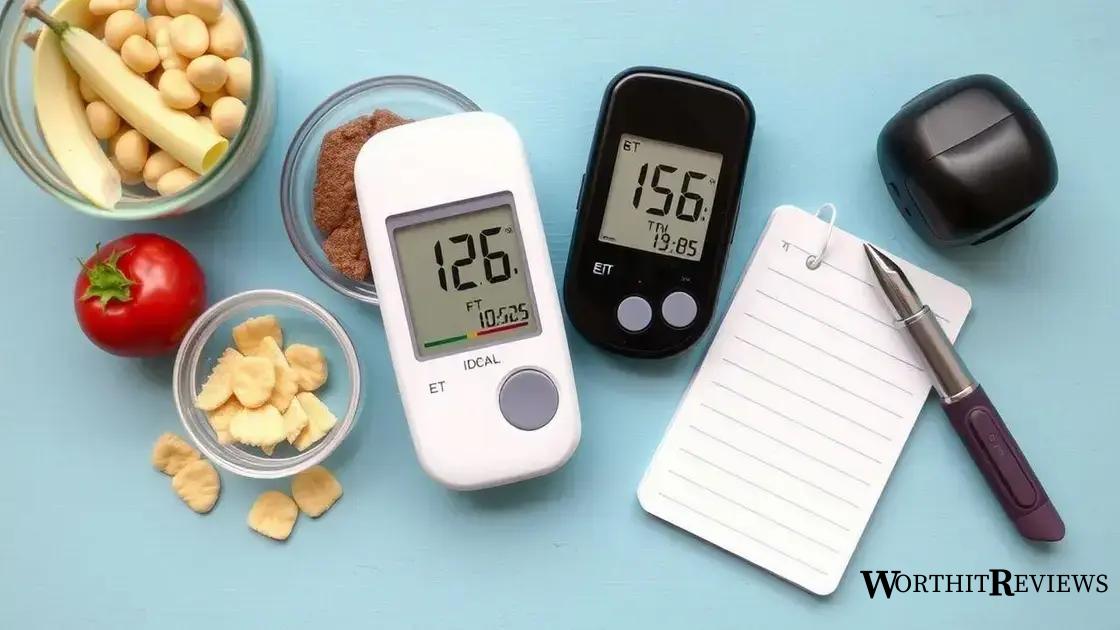The ideal blood sugar range for type 2 diabetes is typically 70 to 130 mg/dL before meals and below 180 mg/dL two hours after eating, essential for effective diabetes management.
Do you know what the blood sugar range for type 2 diabetes should be? It’s essential for anyone managing diabetes to understand their levels. Join me as we explore how to keep your blood sugar in check and why it matters.
Understanding blood sugar and its importance
Understanding blood sugar is crucial for anyone managing type 2 diabetes. Blood sugar, or glucose, comes from the foods you eat. Your body uses this sugar for energy, but too much can lead to serious health problems.
The importance of monitoring your blood sugar lies in its role in maintaining overall health. Regularly checking your levels helps you understand how your body responds to different foods and activities. This knowledge can empower you to make better choices.
For those with type 2 diabetes, elevated blood sugar can cause a range of complications, from fatigue to more serious conditions like heart disease. By keeping your blood sugar within a healthy range, you can greatly reduce these risks.
It’s essential to recognize the factors that influence blood sugar levels. These include what you eat, how active you are, and even stress levels. Knowing how these factors affect your body can help you manage your diabetes more effectively.
Why Blood Sugar Levels Matter
Maintaining healthy blood sugar levels isn’t just about avoiding symptoms; it’s about leading a healthier lifestyle. Keeping your levels stable can improve your mood, energy, and overall well-being.
Ideal blood sugar range for type 2 diabetes

The ideal blood sugar range for type 2 diabetes plays a vital role in managing the condition effectively. Generally, the recommended target for blood sugar levels is 70 to 130 mg/dL before meals and below 180 mg/dL two hours after eating. Achieving these levels helps prevent complications and maintain overall health.
It’s important to remember that individual targets may vary based on factors like age, activity level, and overall health. Discussing your specific goals with a healthcare provider is crucial to ensure the best management plan for you.
Monitoring your blood sugar regularly helps you stay within this ideal range. Using a glucose meter can provide real-time feedback on how food and lifestyle choices impact your levels. Record your readings to track patterns and make informed decisions.
Some factors can cause fluctuations outside the ideal range. These include stress, illness, and changes in physical activity. By understanding these influences, you can take proactive steps to address them and stay in your target range.
Why Maintaining the Ideal Range Matters
Keeping your blood sugar within the ideal range is essential for preventing short-term symptoms like fatigue and long-term complications such as nerve damage and kidney disease. It supports better quality of life and allows you to engage more fully in daily activities.
Factors affecting blood sugar levels
Several factors affect blood sugar levels, and understanding them is key to managing type 2 diabetes effectively. These factors include:
1. Diet: What you eat has a significant impact on your blood sugar. Foods high in carbohydrates, especially sugars, can cause your levels to spike. Choosing whole grains, fruits, and vegetables can help maintain stable levels.
2. Physical Activity: Being active helps your body use insulin more efficiently and lowers blood sugar levels. Regular exercise can aid in managing your weight, which is also important for blood sugar control.
3. Medications: If you take medication for diabetes, it’s important to take it as prescribed. Different medications work in various ways to lower blood sugar, and missing doses can lead to fluctuations.
4. Stress: Stress can cause an increase in blood sugar levels due to the release of hormones like cortisol. Finding healthy ways to manage stress, such as meditation or yoga, can be beneficial.
5. Illness: When you’re sick, your body responds by releasing stress hormones, which can raise your blood sugar levels. Monitoring your levels during illness is essential to keep them within range.
6. Sleep: Poor sleep or sleep disorders can impact insulin sensitivity and lead to higher blood sugar levels. Creating a consistent sleep schedule and practicing good sleep hygiene are important.
How to monitor your blood sugar

Monitoring your blood sugar is a vital part of managing type 2 diabetes effectively. Here are some key steps on how to monitor your blood sugar:
1. Use a Blood Glucose Meter: A blood glucose meter is a common tool used to check your blood sugar levels. To use it, prick your fingertip with a small needle, place a drop of blood on a test strip, and insert it into the meter. It will display your blood sugar level within seconds.
2. Establish a Routine: Consistency is important. Check your blood sugar at the same times each day, such as before meals and before bedtime. This helps you understand how different foods and activities affect your levels.
3. Keep a Log: Recording your blood sugar readings is essential for tracking patterns over time. Write down the date, time, your reading, what you ate, and any medications taken. This can help you and your doctor make informed decisions.
4. Recognize Patterns: Look for trends in your readings. If you notice consistently high or low readings, it may be time to adjust your eating habits, increase physical activity, or review your medications with your healthcare provider.
5. Use Continuous Glucose Monitors: For more advanced monitoring, consider using a continuous glucose monitor (CGM). This device gives real-time readings and alerts you to highs and lows, helping you manage your blood sugar more effectively.
6. Consult Your Healthcare Provider: Regular check-ins with your healthcare team are essential. They can help interpret your readings and suggest adjustments to your management plan as needed.
Diet tips for maintaining healthy levels
A healthy diet is essential for maintaining stable blood sugar levels. Here are some diet tips for maintaining healthy levels:
1. Choose Whole Grains: Opt for whole grains instead of refined grains. Whole grains, like brown rice and quinoa, have a lower glycemic index and can help keep blood sugar levels steady.
2. Include Plenty of Fiber: Foods high in fiber, such as fruits, vegetables, and legumes, slow down the absorption of sugar. This helps prevent spikes in blood sugar after meals.
3. Balance Your Meals: Aim for a balance of carbohydrates, protein, and healthy fats in every meal. This combination helps regulate blood sugar levels and keeps you feeling full longer.
4. Monitor Portion Sizes: Be mindful of portion sizes, especially with high-carbohydrate foods. Using smaller plates and measuring servings can help avoid overeating.
5. Limit Sugary Foods: Try to reduce the intake of sugary snacks and desserts. Instead, satisfy your sweet cravings with fresh fruit, which provides natural sugars along with fiber and nutrients.
6. Stay Hydrated: Drinking plenty of water is important for overall health. Staying hydrated can aid in maintaining stable blood sugar levels.
7. Plan and Prepare Meals: Planning meals ahead of time can help you make healthier choices. Preparing balanced meals and snacks reduces the temptation to grab unhealthy options.
Exercise and its impact on blood sugar

Regular exercise plays a crucial role in managing blood sugar levels for people with type 2 diabetes. Here are some key points about exercise and its impact on blood sugar:
1. Improves Insulin Sensitivity: Physical activity helps your body use insulin more effectively. This means your cells can absorb glucose from the blood better, leading to lower blood sugar levels.
2. Lowers Blood Sugar Levels: Exercise helps to lower blood sugar levels during and after workouts. During exercise, your muscles use more glucose for energy, which helps to reduce the amount of sugar in your bloodstream.
3. Aids Weight Management: Keeping to a healthy weight through regular exercise can help control blood sugar levels. Losing even a small percentage of body weight can improve insulin sensitivity and overall blood sugar control.
4. Provides Stress Relief: Physical activity can lower stress hormones in the body. Since stress can raise blood sugar levels, managing stress through exercise can help maintain stable levels.
5. Encourages Consistency: Aim for at least 150 minutes of moderate aerobic exercise each week, like brisk walking, cycling, or swimming. Consistency is key, so find activities you enjoy to stay motivated.
6. Strength Training Benefits: Incorporating strength training exercises at least twice a week can further enhance muscle mass, which improves your body’s ability to utilize insulin effectively.
7. Monitor Your Levels: Always check your blood sugar before and after exercising. This way, you can understand how different activities affect your levels and adjust your routine accordingly.
Role of medication in blood sugar management
Medications play a crucial role in blood sugar management for individuals with type 2 diabetes. Here are some key points about their importance and function:
1. Types of Medications: There are several classes of medications available to help manage blood sugar levels. These include:
- Metformin: This is often the first medication prescribed. It helps lower glucose production in the liver and improves insulin sensitivity.
- Sulfonylureas: These stimulate the pancreas to produce more insulin, helping to lower blood sugar levels.
- GLP-1 Receptor Agonists: These medications help to increase insulin secretion and decrease appetite, leading to weight loss.
- Insulin Therapy: Some people may need insulin injections to regulate their blood sugar effectively, especially if other medications are not sufficient.
2. Individualized Treatment: It’s important to work with a healthcare provider to determine the best medication regimen tailored to individual needs. Factors include age, weight, other health conditions, and specific blood sugar targets.
3. Monitoring and Adjusting: Regular monitoring of blood sugar levels is essential to assess how well medications are working. Adjustments may be needed based on these readings.
4. Side Effects: Be aware of potential side effects of diabetes medications, which can include weight gain, gastrointestinal issues, or risks of low blood sugar. Discuss any concerns with a healthcare provider.
5. Lifestyle Integration: Medications should be combined with lifestyle changes, such as a balanced diet and regular exercise, to enhance their effectiveness and maintain stable blood sugar levels.
6. Importance of Adherence: Taking medications as prescribed is vital for successfully managing blood sugar. Set reminders or use pill organizers to help remember doses.
Common myths about blood sugar

There are many common myths about blood sugar that can mislead people with diabetes. Understanding the truth behind these myths is essential for effective management. Here are some prevalent misconceptions:
1. Myth: Eating sugar causes diabetes. While a diet high in sugar can contribute to weight gain and increase the risk of developing type 2 diabetes, simply eating sugar does not directly cause the disease. Genetics and overall diet play significant roles.
2. Myth: Only overweight people get diabetes. Diabetes can affect anyone, regardless of weight. Genetics, age, and lifestyle choices also significantly influence the risk of developing type 2 diabetes.
3. Myth: People with diabetes can’t eat carbs. Carbohydrates are an essential part of a balanced diet. It’s about choosing the right types of carbohydrates and managing portions, rather than avoiding them altogether.
4. Myth: If diabetes runs in my family, there’s nothing I can do. While family history is a risk factor, lifestyle changes such as maintaining a healthy weight, eating a balanced diet, and exercising regularly can significantly reduce the risk.
5. Myth: Blood sugar levels only matter for those who take insulin. Monitoring blood sugar levels is essential for all individuals with diabetes, regardless of their treatment plan. Keeping blood sugar within target ranges helps prevent complications.
6. Myth: You’ll know if your blood sugar is high or low. Many people may not experience symptoms until blood sugar levels are significantly high or low. Regular testing is crucial for maintaining safe blood sugar levels.
7. Myth: Natural sugars are always better than refined sugars. While natural sugars found in fruits come with nutrients, they can still impact blood sugar levels. It’s important to consider overall portion sizes and balance.
Managing blood sugar effectively
Understanding blood sugar levels and how to manage them is vital for anyone living with type 2 diabetes. By learning about the ideal range, monitoring techniques, and the role of diet and exercise, you can take charge of your health.
It is also essential to debunk common myths that can lead to confusion and poor management. Education and awareness empower individuals to make informed choices.
With proper management strategies, including medications when necessary, you can maintain healthy blood sugar levels and lead a fulfilling life. Stay proactive, consult healthcare professionals, and embrace a balanced lifestyle to achieve your health goals.
